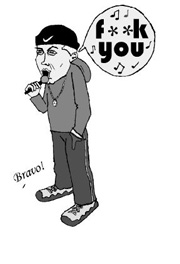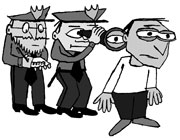“Morality is just another form of social control.” —Feral Faun, in the Eugene-based ‘zine Revolt!
It is a Friday night in Eugene, Oregon. I’m in a converted warehouse that now houses an organic drink bottler and the epicenter of Eugene’s new anarchist movement: a coffeehouse called Out of the Fog.
Contrary to the stereotype of menacing, bomb-toting anarchists, the place is friendly and it’s hopping. Out on the patio, a DJ spins records while a young man with dreads dances wildly, oblivious to tables inches away. Inside, with the obligatory caffeine, juice, and pastries, the walls are lined with tributes to our decaying, unjust society: articles on irradiated food and nearby tree sits to stop clear-cut logging; petitions to stop the execution of death row inmate Mumia Abu-Jamal; a tableau on cooperative coffee growing in rural Mexico; flyers for imprisoned anarchist activist Rob Thaxton and for a community-wide nonviolence training; schedules for an anarchist free school; and much more.
At our table, a young adult—who doesn’t want to be identified for fear of reprisal from Eugene’s police—animatedly describes working as an alternative media reporter and being arrested in Eugene’s now-infamous June 18 riot. A call is put in to three teens who might want to talk—they were among the rock-throwers that day. It turns out two are not home—they’re off at a Friday night meeting of a martial arts class at the new anarchist free school that’s been organized this summer. Back at the table, we’re drawing a crowd; everyone knows someone there, and everyone has a story. To properly describe the anarchist cause, a young man named Exile dashes home to get his copy of the ‘zine Black Clad Messenger (“Actualizing industrial collapse!”). Another young man, Kook, offers his own ‘zine, a tract ranting about the outrage of the NATO bombing of Yugoslavia. It’s a scene unlike anything in Seattle, a place where societal outcasts are at home, a sort of politicized Cheers for folks with tattoos, dreads, or facial piercings.
Eugene—Oregon’s second largest city—has been a countercultural haven for at least the last 30 years. Home of the University of Oregon and a large contingent of resettled ex-hippies from California, it is a sometimes uneasy mix of loggers, southern Willamette Valley hay farmers, university professionals, Hyundai workers, and young idealists of all stripes. And it is a mostly tolerant city that, in the last year, has been polarized by a relatively small group of anarchists advocating intentional, targeted property destruction as a response to gentrification and the ills of modern society.
Seattle, like Eugene and most other cities, has always had at least a few anarchists. Here, there are some visible anarchist institutions: Left Bank Books, Books to Prisoners, Copwatch, the late Black Cat Cafe. Dating back to the early-century heyday of the Wobblies, the Northwest has always been one of the country’s strongest bases of anarchism. At its core, anarchism is neither intrinsically violent nor disorganized. It has a relatively simple premise: government, all government, is inherently coercive and violent, and like all institutions will act primarily to expand its own power. Anarchism is, in its purest form, hostile both to the left, with its reliance on government social programs, and the right, with its emphasis on military spending and government social control. All government has got to go. Ambiguity over how, and what it’s to be replaced with, is one reason there are so many subsets of anarchism.
In the last year, a new, more militant anarchist strain asserted itself in Eugene. A movement of at least several dozen, mostly young—teenagers and people in their early 20s—activists emerged around John Zerzan, longtime local anarchist writer and theoretician. Zerzan is the author of books that are deeply controversial in anarchist circles: Elements of Refusal, Future Primitive, and others. He is a leading advocate of primitivism, which goes far beyond matters of how the state is or isn’t constructed, considering technology and most of what we consider civilization to be deeply pathological and needing to be eliminated. This short-on-details passage from Elements is typical: “Upon the utter destruction of wage-labor and the commodity, a new life will be situated and redefined, by the moment, in countless, unimagined forms. Launched by the abolition of every trace of authority . . . concepts like ‘economy,’ ‘exchange,’ [and] ‘production’ will have no meaning. (What is worth preserving from this lunatic order?)”
Last fall, primitivist anarchists hijacked an antisweatshop demonstration, romping through a downtown Eugene Nike store, breaking windows and overturning displays. A campaign of random minor property destruction—graffiti, broken windows, and the like—plagued new upscale businesses in the lower-income Eugene neighborhood of Whitaker. One of the upscale businesses, the Blair Island Cafe, closed, prompting anarchists to declare victory. And then came the June 18 “riot.”
The June 18 disturbance grew out of a scheduled “Reclaim the Streets” protest coinciding with demonstrations around the world against G-7 economic powers meeting in Cologne, Germany. The idea was to occupy a downtown Eugene intersection for a couple of hours with a block party: music, dancing, speeches. What happened was that after a while the crowd got bored and a faction of it took off. Some 200 people started roaming from business to business in downtown Eugene, with rocks being thrown through the windows of particularly reviled businesses (such as a local bank associated with underwriting clear-cutting). In a few cases, cars were jumped on, and one frustrated motorist in the blocked traffic attacked a protester with a wrench. Police essentially followed the crowd but did not interfere until it began to disperse in a park near Whitaker. Then police launched volleys of tear gas and began arresting people—20 arrests in all. The police action prompted another couple of hours of marching and looting before the whole thing played itself out.
As riots go, it was relatively mellow. One African-American transplant to Eugene from back east notes, “Where I come from, riots have body counts.” All told, there was about $20,000 in property damage. But the event sparked outrage among local politicians and in the local paper and talk shows, and revealed a deep split within Eugene’s normally inclusive activist community.
“They’ve pissed a lot of people off,” says Cindy Noblitt, one of the city’s most visible left activists. Referring to the anarchists’ campaign of low-key property destruction, she continues: “John Zerzan is a very divisive and negative fellow.” Noblitt sees the specter of anarchists forcing others to toe their line or face their consequences as not only hypocritical, but ultimately ineffective: “I don’t believe they can pull off a revolution that’s going to destroy the system without some level of popular support. I don’t believe that using coercion to build a noncoercive society is going to work.”
The anarchists, for their part, are not only unapologetic about the events of June 18, they are positively giddy. An article in Black Clad Messenger describes how “. . . [protesters] took it upon themselves to engage in an offensive attack against capitalist domination of humans and nature. . . . The unity and cohesion of the marchers, and their feral embrace made them unstoppable by local authorities.”
In person, John Zerzan is surprisingly mild-mannered and friendly. The day before we met, he held court for four hours for a recon crew from 60 Minutes; CNN, the BBC, The Wall Street Journal, and the LA Times had all called the 55-year-old Zerzan hoping to find a story about the next big youth movement. His idealism sounds almost Republican. “The question is,” he asks, in advocating destruction of modern civilization, “what sort of a world do we want for our children?”
To the extent that there is sympathy among Eugene’s activist community for the anarchists’ tactics, it comes because of fear and anger over the gentrification of Whitaker. To Zerzan, the revolution is local. He not only defends property destruction as necessary and inevitable—and relatively minor compared to the organized violence of Eugene’s police—but points out that without it, the anarchists and the issues they raise would be ignored. Insofar as the effectiveness of property destruction in preventing gentrification is concerned, Zerzan’s response is simple: “Show me something else that works.”
Noblitt doesn’t buy it. “I don’t think [the anarchists campaign of property destruction] had that much of an effect. I think gentrification [happens] less because nice businesses move in than because of general good economic times.” And she then dismisses gentrification as not that important an issue anyway, not like the loss of old growth forests.
Throughout the last year, Eugene’s police have been the anarchists’ best recruiting tool, repeatedly proving their point about the oppressiveness of the state. Resentment dates from an infamous incident in June 1997 when nonviolent downtown tree sitters had can after can of pepper spray emptied on them.
Brenton Gicker, a 15-year-old anarchist whose fingerprints were on a flyer left at last fall’s Nike protest, had his family’s house subsequently raided by 13 EPD officers who searched the house for seven hours, seizing computers, literature, clothing, school work, and personal items of all of the family members as “evidence” for participation in a protest where nobody was hurt and nothing was stolen. The family is considering a lawsuit against the city.
How does a 15-year-old—or dozens of teens—become involved in a radical, angry political movement? “Just taking a look at the state of the world,” Gicker says, “anarchy is appealing. [The last years’ police response] has totally validated my anti-authoritarian perspective.”
Why Eugene? This summer’s anarchist resurgence comes in part from the recent history of radical forest encampments and tree sits to prevent old growth clear cuts. A network of such encampments has sprung up throughout the Northwest; the most visible is just outside Eugene, at Fall Creek, and is in its 15th month.
At the Out of the Fog coffee shop, activist Dean Rimerman proudly narrates how the “new school” of working class youth from the streets of Eugene got their first exposure to the woods and to anarchist, decentralized community and decision-making at Fall Creek. He contrasts it with the “old school” tree sit of middle-class hippies at Warner Creek, also near Eugene, way back in 1995-96. The combination of street youth and woods warriors, according to Rimerman and others, has made both for tougher forest protests and helped account for Eugene’s unique position in spawning an antitechnology anarchist movement.
It’s fairly clear what’s next: Seattle. Just as the June 18 protest was inspired by the international economic order, the World Trade Organization talks in Seattle in November will be drawing the anarchists as well as busloads of others from Eugene. Anarchist contingents for the WTO protests are already being organized, and they will be heavily influenced by primitivism. The visibility of the Eugene movement and its success in raising the question of how best to respond to the desensitizing march of techno-progress has galvanized anarchists across the nation, including here in Seattle. Wesley Everett of Left Bank Books says that “Many anarchists and everyday working people sympathize with the actions of Eugene’s anarcho-ecoteurs. They understand the gesture.”
While the Eugene movement has spawned community institutions like the free school and a new cable access TV show, it is primarily oppositional. For Zerzan, the issue of what should replace our techno-civilization is almost irrelevant: “What do you replace cancer with?” he asks. “The bottom line is, how bad do you think it is?”
The presence of a tolerant university community and a radical environmental movement helped spawn primitivism, but the questions it raises and its appeal to young idealists are just as relevant in a larger city like Seattle. In an alienating society, what do we have to offer youth that’s more constructive than breaking windows? Answers to that question aren’t easy, but we had better learn to articulate them soon.






